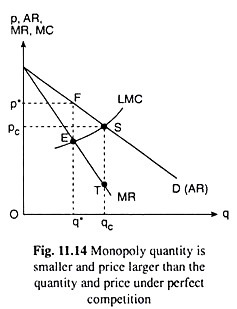Learn about the comparison between long-run equilibrium under monopoly and perfect competition.
In long-run equilibrium under perfect competition, the price of the product becomes equal to the minimum long-run average cost (LAC) of the firm. In monopoly, on the other hand, long- run equilibrium occurs at the point of intersection between the monopolist’s marginal revenue (MR) and long-run marginal cost (LMC) curves.
Since at the minimum point of the LAC curve, LAC = LMC, we have price = LMC in the long-run equilibrium of the competitive firm. On the other hand, in monopoly, p = AR > MR at each output.
Therefore, at the long-run equilibrium output at the MR = LMC point, we have, for the monopolist, p > LMC. In other words, in the long-run equilibrium, price is equal to marginal cost for the competitive firm and price is greater than marginal cost for the monopolistic firm.
ADVERTISEMENTS:
Now, under certain conditions, demand price for a commodity represents its marginal social valuation. Similarly, long-run marginal cost usually represents the marginal social cost of production. Therefore, under monopoly, the marginal value of a commodity to society exceeds the marginal cost of its production to society.
The society as a whole would benefit, therefore, if more and more of its resources are used in the production of the commodity till p becomes equal to MC. However, the profit-maximising monopolist would not set the price of its product equal to marginal cost.
For, then, it would have to operate at a point where MC = p = AR > MR => MC > MR, which would result in a loss on the marginal unit(s) of its output, and profit- maximisation would not be possible.
We may illustrate the point with the help of Fig. 11.14. Here at the MR = MC point E, the first-order condition (FOC) for maximum profit has been satisfied as also the second order condition (SOC), for at the point E, the negative slope of the MR curve is smaller than the positive slope of the LMC curve. Therefore, the monopolist’s profit-maximising price-output combination is F (p*, q*).
ADVERTISEMENTS:
But, the society would benefit if the firm operates at the p = MC point, S, where the price-output combination is S (pc, qc). But at this point MC = p = AR = Sqc is larger than MR = Tqc i.e., at the point S, MC > MR, and so, the firm would be making losses on the margin. In order to maximise profit, the firm would want to reduce its output till it becomes equal to q*.
As we have seen, from the point of view of the society as a whole, the p = MC output, qc, is efficient and the MR = MC output, q*, is inefficient. Therefore, for the benefit of the society as a whole, the firm should produce qc and not q* of output. In order to ascertain this, let us suppose that the firm produces an output q = q*.
It is seen in Fig. 11.14 that at q = q*, the consumer is willing to pay p*, i.e., the value of the marginal unit of the good to the consumer is p* which is greater than the cost of production of the marginal unit, Eq*. Therefore, for the sake of efficiency, the good should be produced in a larger quantity till p reduces from p* to pc and output increases from q* to qc at the p = MC point, S, on the demand curve.
We may conclude, therefore, that efficiency from the point of view of society is achieved at the long-run equilibrium point of the competitive firm, and it is not achieved at the long-run equilibrium point of the monopolist. The reason is obvious. The latter possesses market power while the former does not.
